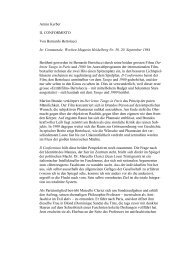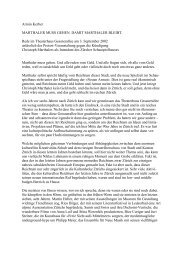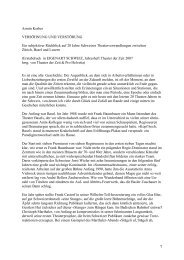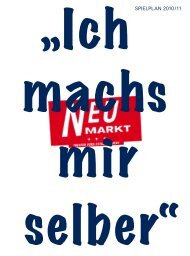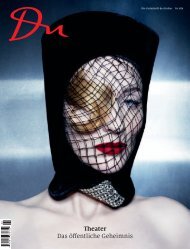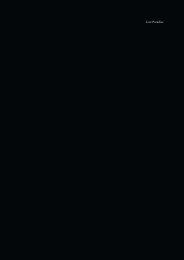You also want an ePaper? Increase the reach of your titles
YUMPU automatically turns print PDFs into web optimized ePapers that Google loves.
<strong>Lost</strong> <strong>Paradise</strong> – “Tu n’as rien vu à Hiroshima”<br />
can and Indian animals, such as lions and tigers. During the unrests following<br />
1997, however, most of them were either “kidnapped” or killed.<br />
Sala was featured prominently at Remind, the 2004 group show at<br />
Kunsthaus Bregenz. The catalogue comments, “The loss of social order<br />
becomes tangible in the juxtaposition of interior and exterior – of animal<br />
enclosures and adjacent green spaces. Following the economic depression<br />
of the late 1990s, only a few animals languish in decrepit cages. Packs of<br />
dogs rather than people now roam about the rundown visitors’ facilities.<br />
Masterless witnesses of urban decay, they have seized the space that has<br />
become a mirror image of the decay of a repressive system and subsequent<br />
economic bankruptcy. The original concept of a zoo as a representative<br />
facility of display, education and science has been turned into its very opposite.<br />
Anri Sala’s Arena has become a location that documents past imprisonment,<br />
oppression and death. His focus on its geographical and<br />
cultural origins provides a stark contrast to the present. The zoo recalls<br />
Albania’s political and social past, as well as its present reality.”<br />
The complex choreography of Dutchman Aernout Mik’s 2006 video<br />
piece Scapegoats shows the rituals enacted between an<br />
imprisoned civilian popu- lation and their paramilitary<br />
guards. It demonstrates that it is an important, almost<br />
self-evident concern of current art production to inflitrate documentary<br />
strategies employed by television, the press, the radio and the internet. Infiltration,<br />
montage and alienation are art’s strategies to denounce the ways in<br />
which information and disinformation have been produced – not only since<br />
the advent of “embedded” war journalism. It debunks the lies of the media,<br />
usually by assuming the role of a counter-information platform, revealing<br />
the potential plural forms of “information”. Resorting to mainstream codes<br />
and reclaiming public space by means of aesthetic guerrilla tactics, art creates<br />
a space wherein the power of the media can be discussed.<br />
The Polish artist Zbigniew Libera illustrates this by re-producing<br />
famous 20th-century press photographs, alienating them in such a way<br />
that the viewer only realises at a second glance that something cannot be<br />
right: for example, it is a mutilated Che Guevara who shares a peaceful<br />
smoke with his persecutors; the face of the Vietnamese girl running away<br />
from the Gis is smiling, as are the men behind the barbed-wire fence of<br />
the prisoner-of-war-camp – as though they all lived in a world<br />
in which information is part of the entertainment industry’s<br />
drip-feed.<br />
58



